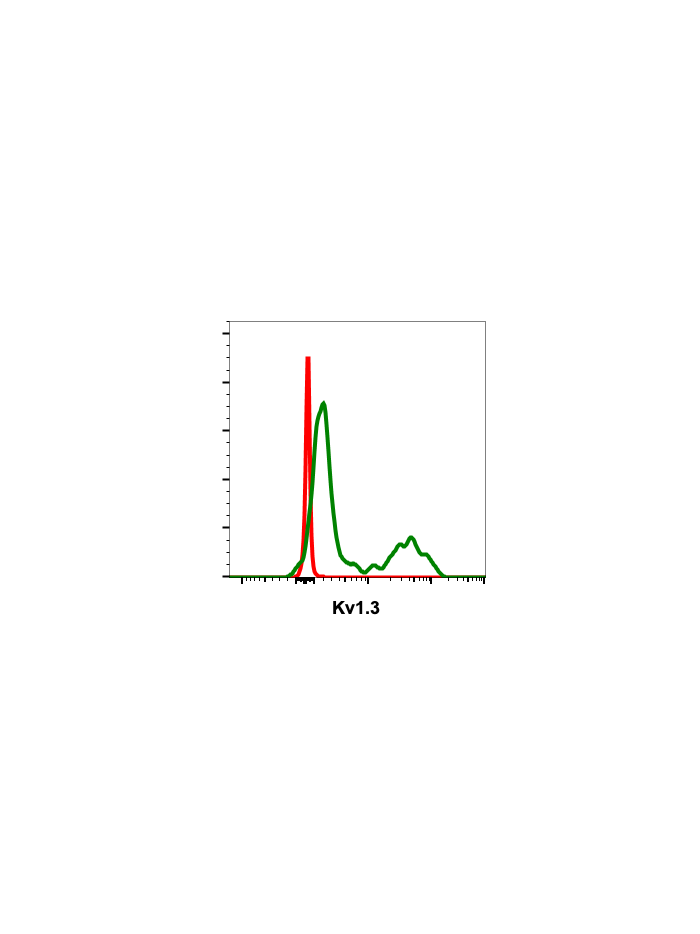Kv1.3 (26B-R4-D9) rabbit mAb
From
$210.00
In stock
Only %1 left
SKU
2556
Voltage-gated potassium channels (Kv) are integral membrane proteins, which are selectively permeable for potassium ions and are activated upon a change of cell membrane voltage. Activation of these membrane embedded proteins facilitate transportation of potassium ions across cell membrane down their electrochemical gradients. Kv1.3 is a classical Shaker-type potassium channel with six transmembrane segments (1), was first discovered in one of the non-excitable cells, T lymphocytes (2). KV1.3 are expressed in human T and B lymphocytes, macrophages, fibroblasts, platelets, osteoclasts, microglia, oligodendrocytes, brain (e.g., olfactory bulb, hippocampus, and cerebral cortex), lung islets, thymus, spleen, lymph nodes, and testis (3). It is also expressed in the inner mitochondrial membrane (mito Kv1.3) of normal T lymphocytes and cancer cells (4). Kv1.3 is the first K+ channel to be identified outside electrically excitable tissues. Kv1.3 in T lymphocytes is responsible for controlling the membrane potential which is critical for the activation of these immune cells.
Kv1.3 plays an important role in cell proliferation and apoptosis. The channel activity is inhibited by many chemically unrelated compounds: heavy-metal cations, small-molecule organic compounds and venom-isolated oligopeptides (3, 5). The most potent specific inhibitors inhibit the channel at sub nanomolar concentrations (7). Inhibition of Kv1.3 channel by specific inhibitors may be beneficial in therapy of T-lymphocyte-mediated autoimmune diseases (e.g., sclerosis multiplex, type I diabetes mellitus, rheumatoid arthritis, psoriasis), chronic renal failure, asthma, obesity, type II diabetes mellitus, cognitive disabilities, and some cancer disorders (7).
| Applications | Flow Cytometry |
|---|---|
| Clone | Kv1-3-26B-R4-D9 |
| Format | Unconjugated |
| Validated Reactivity | Human |
| Cross Reactivity | Predicted to work with mouse, rat and other homologues. |
| Detection | Anti-Rabbit IgG |
| Clonality | Monoclonal |
| Immunogen | Synthetic peptide |
| Formulation | 1X PBS, 0.1% BSA and 0.025% azide |
| Isotype | Rabbit IgGk |
| Preparation | Protein A+G |
| Recommended Usage | For flow cytometric staining, the suggested use of this reagent is 5 µL per million cells or 5 µL per 100 µL of staining volume. It is recommended that the reagent be titrated for optimal performance for each application. See product image legends for additional information. |
| Storage | 2-8ºC |
| Pseudonyms | Potassium voltage-gated channel subfamily A member 3, Kv1.3, KCNA3, HGK5 |
| Uniprot ID | P22001 |
| References | 1. Wulff H, Zhorov BS, (2008). Chem. Rev. 108:1744–1773. 2. Chiang EY, et al., (2017) Nat. Commun. 8:14644. 10.1038/ncomms14644 3. Gutman G, et al. (2005) Pharmacol Rev (2005) 67:473–508. 4. Szabo I, et al.. (2005) J Biol Chem. (2005) 280:12790–12798. 5. Panyi G, et al., (2006) Curr Pharm Des. 12:2199–220. 6. Serrano-Albarras A, et a., (2018) Exp Opin Therapeut Targets. 22:101–105. 7. Teisseyre A, et al., (2015) Adv Clin Exp Med. 24:517–524. |
Write Your Own Review

